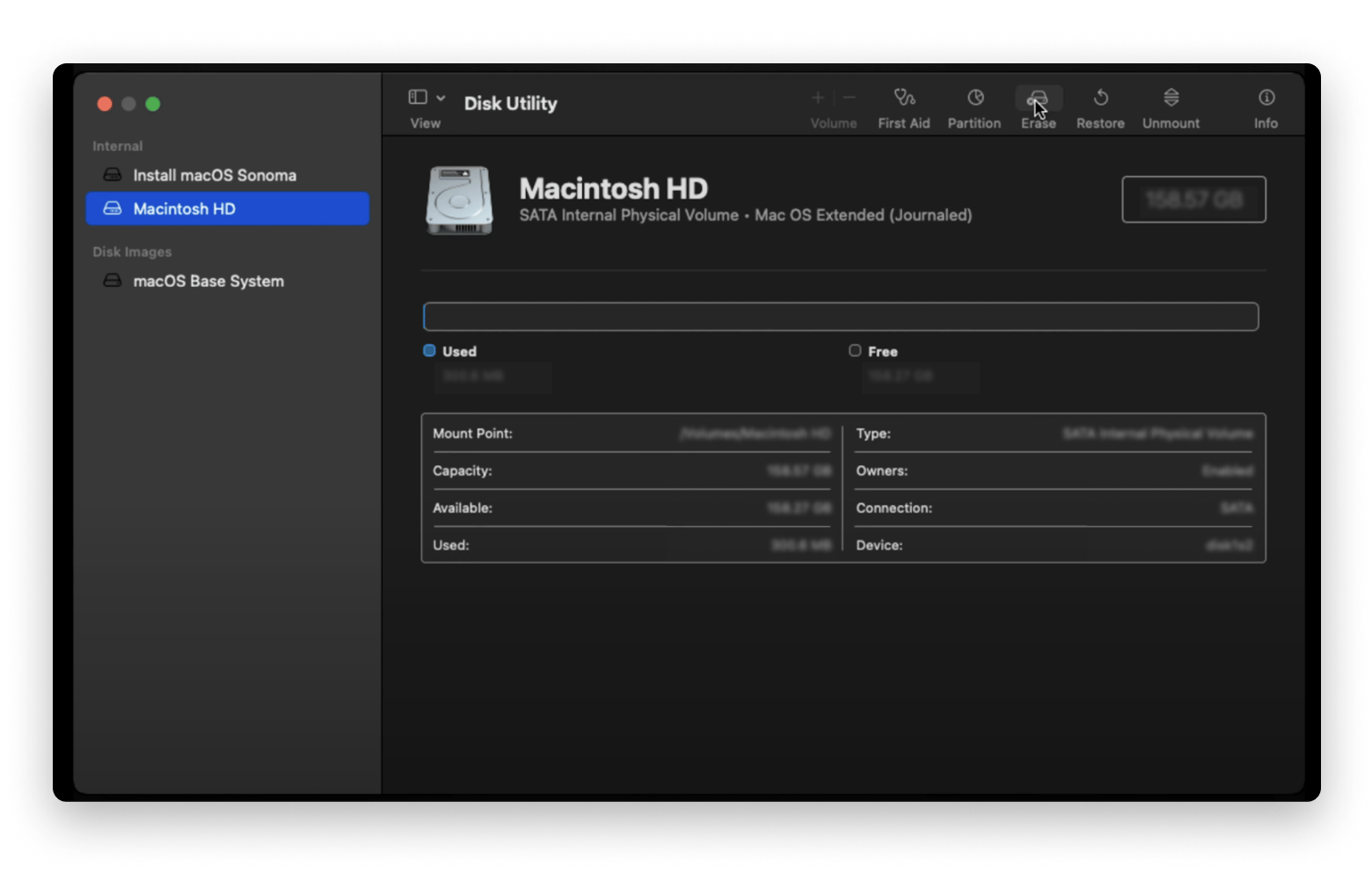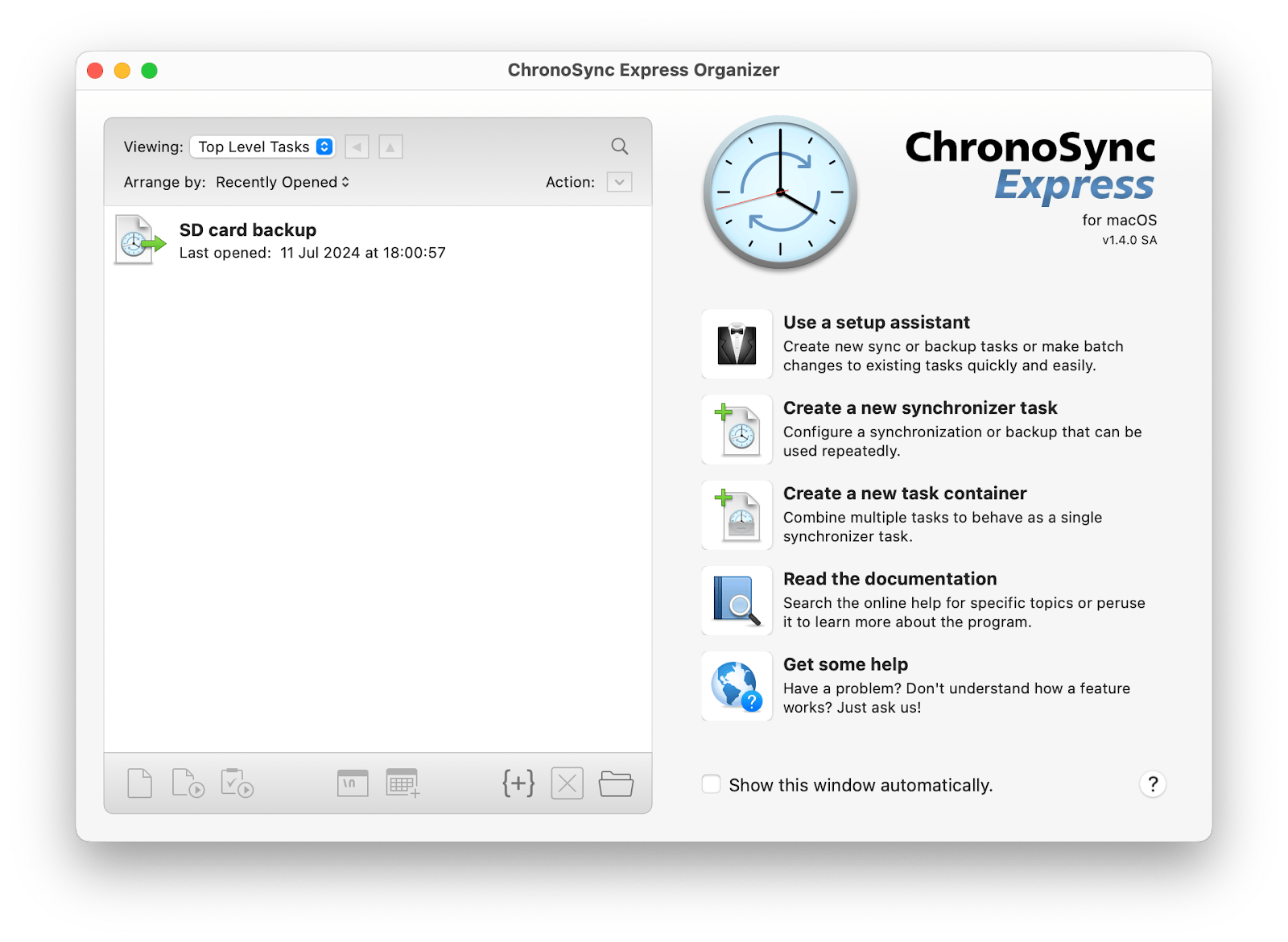How to factory reset a MacBook | 2025-2026
- Factory reset gives your Mac a clean slate.
A factory reset wipes all data and reinstalls a fresh copy of macOS — ideal if you’re selling your Mac, facing performance issues, or dealing with malware. - Back up before you reset.
Use apps like Get Backup Pro or ChronoSync Express from Setapp to clone your Mac or save essential files safely for recovery. - Different macOS versions, different reset steps.
Macs running macOS Monterey or later (with Apple Silicon or T2 chips) can use Erase Assistant under System Settings > General > Transfer or Reset. Older Macs rely on Recovery Mode and Disk Utility for manual erasing and reinstalling. - Sign out and unpair before erasing.
Always sign out of iCloud, iMessage, Music, and other Apple services, and unpair Bluetooth devices to avoid setup issues or lingering account connections after reset. - Optimize before resetting.
Sometimes a full reset isn’t needed. Try CleanMyMac from Setapp to remove junk files, fix performance issues, and detect malware — giving your Mac a fresh feel without wiping it completely. Try CleanMyMac from Setapp + over 250 other apps 7 days free.
Remember: Mac factory reset erases all your data and reinstalls a fresh version of macOS. Basically, it’s like getting a brand-new Mac.
In this step-by-step guide, I’ll show you how to factory reset a MacBook running different versions of macOS and how to preserve all your data. This tutorial applies to MacBook Air, MacBook Pro, and iMac.
Need a quick solution? Describe your needs to our free AI Assistant Fix My Mac | Beyond Basics, and get an instant answer.
How to factory reset a Mac: Key solutions, briefly
Let me start with quick solutions, and below, I'll give you detailed instructions, screenshots and tips.
| Problem | Solution |
| Mac running slowly or freezing | Try cleaning junk, caches, and malware with CleanMyMac before attempting a full reset. |
| Need to securely erase data before selling or giving away Mac |
Perform a factory reset using Erase Assistant (for macOS Monterey or newer): 1. Open System Settings > General > Transfer or Reset. 2. Select Erase All Content and Settings. 3. Enter admin credentials. 4. Back up if prompted. 5. Review and confirm erasure. |
| Using older Mac without Erase Assistant | Boot into Recovery Mode, erase the disk via Disk Utility, and reinstall macOS manually. |
| Can’t erase Mac due to missing assistant or old hardware | Sign out of all accounts, unpair Bluetooth devices, erase manually in Recovery, and reinstall macOS. |
| Worried about losing files during reset | Use Get Backup Pro or ChronoSync Express to back up or clone your Mac before erasing. |
| Mac won’t boot or is unresponsive | Start in Recovery Mode and erase disk using Disk Utility → then reinstall macOS. |
| Forgotten password or Apple Account | Boot into Recovery Mode, use Disk Utility to erase the disk, then reinstall macOS. |
Reasons to factory reset a Mac
Before you perform a MacBook factory reset, do you really need to take such a drastic measure? Trust me, it’s really frustrating to opt for a factory reset only to find out that the solution is something more superficial. Plus, the risk of losing important data is real. Once, I lost all my photos that were not synced to iCloud because I was too eager to factory reset my Mac.
So, what are the valid reasons for a factory reset? Here are common causes:
- You want to sell your MacBook. A full reset prevents data you save on the Mac from falling into the wrong hands.
- Your Mac has been infected with malware. You can perform a full factory reset after you back up your data with Get Backup Pro.
- Your Mac is experiencing performance issues. A factory reset can be effective, but it should be treated as a last resort.
How to factory reset your MacBook: A guide for the 5 latest macOS
Apple maintains a relatively consistent workflow for factory resets, but some steps of might vary for later devices.
How to factory reset your MacBook on macOS Tahoe, macOS Sequoia, macOS Sonoma, macOS Ventura, and macOS Monterey
Starting with macOS Monterey (version 12) and later, MacBooks gained a useful new feature called Erase Assistant. It’s available on MacBooks with Apple Silicon and Apple T2 Security Chip running macOS Monterey or newer.
If your MacBook runs on macOS Tahoe, Sequoia, Sonoma, or Ventura, here’s the best way to restore it to factory settings:
- Go to the Apple menu in the upper left corner of your screen.
- Click System Settings (or System Preferences for older operating systems) .
- Click General, then Transfer or Reset.
- Select Erase All Content and Settings.
- When Erase Assistant appears, enter your admin credentials and click Unlock.
- Back up your files when prompted. Otherwise, proceed to confirm your choice.
- Review the list of items, apps, and information that will be removed along with your content and settings.
- When ready, click Continue and follow the on-screen instructions.
Your Mac might ask you to create a backup on Time Machine. You will see a final prompt that warns you that you’re about to delete all data. Click Erase All Content & Settings to start the reset.
Once your Mac restarts, a helpful setup assistant will walk you through the setup process as if it's your first time setting up your Mac. You may need to connect to a keyboard, mouse, or Wi-Fi network. After a while, you’ll see the Hello screen. And that’s the sign that you’ve reset your MacBook Pro, MacBook Air, or iMac to factory settings.
When Erase Assistant finishes its work, your Mac becomes completely clean — free of any data, traces, or references to you. It’s just like getting a brand-new MacBook (in terms of its content, of course). Here is what Erase Assistant does:
- Signs you out of all Apple services
- Turns off Find My and Activation Lock
- Deletes all your content, settings, and any apps you’ve installed (while keeping the built-in Apple apps)
- Removes all volumes.
- Erases all user accounts and their data.
Important!If you share your MacBook with others, be aware that their information will also be erased. Make sure every user has backed up their data. |
How to factory reset your MacBook on macOS Monterey that doesn't support Erase Assistant
If your MacBook is running macOS Monterey, you have two options to perform a factory reset, and it depends on your Mac's chip. To check this, click the Apple logo in the upper-left corner, select About This Mac, and review the information displayed.
If you see that your Mac has Apple Silicon or an Apple T2 Security Chip, this means your Mac supports Erase Assistant described in the previous paragraph. So, simply follow the instructions described above — the factory reset process will be essentially the same.
If you see a different type of chip (typically, an older Intel-based Macs), your reboot process will take a bit longer — but don’t worry, we’ll get through it together!
Here’s how to reset your Mac to factory settings if you’re running macOS Monterey or earlier:
- Enter macOS recovery mode: Shut down your Mac > Press and hold the power button for about 10 seconds until it turns off > Press and release the power button again to turn it back on.
- Select your Wi-Fi network, startup disk, and user account.
- When the Recovery window appears, click Disk Utility.
- In the sidebar, select Macintosh HD, then click Erase.
- If needed, specify the name and format (Macintosh HD; APFS or macOS Extended (Journaled).
- Click Erase Volume Group and confirm your selection.
You're done!
How to factory reset your MacBook manually
If your Mac is unresponsive or unable to boot into macOS, you must use Recovery Mode to run a factory reset. Resetting sounds intimidating because it requires more steps. Well, it isn’t. As long as you can boot your Mac to Recovery Mode, the others are straightforward.
How to reset your Mac with Recovery Mode
If you’re using an M-series Mac, follow these steps:
- Turn off your Mac.
- Press and hold the power button and then click Options.
- Click Continue and enter your administrator password to start macOS recovery.
For Intel-powered Macs and earlier, do this:
- Power off your Mac.
- Press the power button with Command + R.
- Release the buttons when you see the Apple logo.
- Select a user and click Next.
- Enter your administrator password to proceed.
Once your Mac is in Recovery Mode, follow these steps to erase the disk:
- Enter your administrator password.
- Select Disk Utility in the macOS Utilities window > Continue.
- Choose Macintosh HD > Erase.
- Enter Macintosh HD in the Name field.
- Choose APFS or macOS Extended (Journaled) as the format (APFS is recommended for macOS 10.13 and later).
- Click Erase Volume Group or Erase.
Your Mac will start wiping out the files. And all you need to do is wait.
How to reinstall macOS
After erasing the disk, you can reinstall macOS to set up your Mac as if it were new.
To do that:
- Boot your Mac into Recovery Mode.
- Click Reinstall macOS.
- Follow the on-screen instructions.
The installation might take a while. And when it’s done, you’ll be greeted by the familiar welcome screen. Here, you can check out the full list of all macOS versions.
What to do if you can't erase your Mac
If your MacBook is of an older model and doesn’t have Erase Assistant, or you can’t easily erase it for any other reason, there’s a workaround — you’ll need to manually remove all private and sensitive information anyway, right? Especially if you’re preparing your MacBook for sale, trade-in, or exchange.
If you can’t erase your Mac, follow these steps:
- Back up your MacBook if you want to save your information or transfer your files to another Mac or an external hard drive.
- Sign out of all your accounts: iTunes, iCloud, iMessage.
- Cancel your AppleCare plan. Or pass it to the new owner if you're resetting for sale.
- Unpair your Bluetooth accessories.
- Use Disk Utility in macOS Recovery to erase your Mac.
- Reinstall macOS from Recovery.
- After reinstalling, your Mac will launch Setup Assistant to help you set up the device. If you’re selling or giving it away, press Command (⌘) + Q to quit Setup Assistant.
- Reset NVRAM. After this, your Mac will prompt Setup Assistant again. Once more, press Command (⌘) + Q to quit Disk Utility.

What to do before you restore Mac to factory settings
It’s always wise to double-check before getting to factory settings. So, here’s what you need to do before resetting your Mac.
#1. Backup your Mac with third-party tools
The worst nightmare is losing all your files. As a rule of thumb, backing up your data is the first and most essential step in this case. A great tool that will save your nerves is Get Backup Pro. The app lets you clone your entire Mac or save only essential files to an external storage. If needed, you can recover those files to another computer.

If anything ever goes wrong, this backup software will quickly recover your data on any Mac, even if the app isn’t installed there. It's a great way to protect yourself from any unexpected catastrophe.
Alternatively, you can try ChronoSync Express. Like Get BackupPro, it allows you to create backup copies of your Mac. But the great thing with ChronoSync is that it can automatically send you email and system notifications about your computer’s activity when you're away.

#2. Sign out of Apple Services
If you’re signed in to Music, iCloud, and iMessage, you should sign out from them before resetting your Mac. To deactivate, open Music App > Account > Sign Out.
Just a friendly reminder that if you're already signed in to Podcasts or the Apple TV app, you're automatically signed in to Music.
To sign out from iCloud on different macOS versions, follow these steps:
- For macOS Ventura or later. Go to System Settings > Apple Account > Sign out.
- For macOS Monterey or older. Go to System Settings > Overview > Sign out.
Another service that you’ll want to log out before resetting your Mac is iMessage. Here’s how:
- Open Messages.
- Click Settings.
- Click iMessage > Settings > Sign out.
Now, your Mac will not accidentally reconnect to any of them after a complete reset.
#3. Unpair Bluetooth devices
If your Mac is paired to Bluetooth devices, you might experience technical issues or glitches when setting up after reinstallation. To prevent that, unpair all connected Bluetooth devices:
- Open System Settings on the menu bar.
- Click Bluetooth.
- Click on the information icon.
- Click Forget This Device.
If you perform a factory reset without any device connected to your Mac, there’s less risk of disruption.
Important!If you often work with Apple devices, you might need tools to check their authenticity, specs, manufacturing date, compatible models, and more. For that, try our ChatGPT-based Free AI Assistants:♦ Apple Serial Lookup & IMEI Checker ♦ iPhone Serial Number Lookup ♦ Mac Serial Number Lookup ♦ iPad Serial Number Lookup ♦ AirPods Serial Number Check ♦ Apple Watch Serial Number Lookup ♦ Apple Warranty Check |
Now, you can completely reset your MacBook
By now, you’ve learned different ways to reset your Mac to factory defaults. While wiping your Mac is quite straightforward, you must be mindful of potential complications, particularly if you forget to back up your files.
You can use Get Backup Pro and ChronoSync Express to back up your files before resetting the Mac. And if you’re not ready to reset your Mac, then CleanMyMac is a great option to declutter your device from garbage and make it as fast as new. These apps are available with a Setapp subscription, a platform with dozens of useful apps you can try with a seven-day trial. Why wait?
FAQ
Can I reset MacBook to factory settings without Apple Account?
If you can’t remember your Apple ID, boot your MacBook into Recovery Mode. There, you can manually perform a factory reset using Disk Utility.
How to factory reset a MacBook without a password
The easiest way to reset your MacBook without a password is through Disk Utility. You can access it by booting your Mac into Recovery Mode.
Does a factory reset delete everything on MacBook?
When you factory reset your Mac, all files, settings, passwords, and personal data will be wiped. Use Get Backup Pro to back up your files before resetting a Mac.
How to do a factory reset on MacBook without logging in?
Use the Disk Utility in macOS recovery to reset your Mac if you can’t log in. To do this:
- Turn off your MacBook.
- Hold Command + R and press the power button.
- Release when the Apple logo appears.
- Click Disk Utility to erase the disk and reinstall macOS.
How do I factory reset my Mac without assistant?
If you’re using an older version of Mac that doesn’t have the Erase Assistant, you can:
- Boot your Mac into Recovery Mode.
- Erase the drive with Disk Utility.
- Reinstall the MacOS.
With that, you can restore your Mac to factory defaults.





